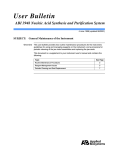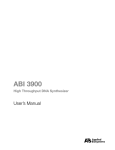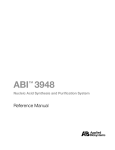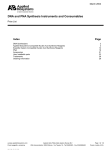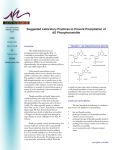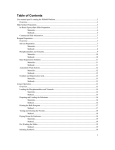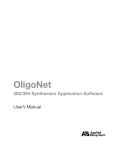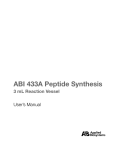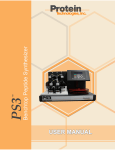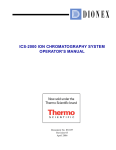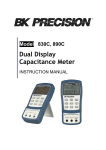Download Labeling and Purification of Oligonucleotides with the
Transcript
390012-AB May 2002 TM CEQ 8000 ™ Genetic Analysis System Labeling and Purification of Oligonucleotides with the Beckman Coulter, Inc. WellRED Dye-labeled Phosphoramidites Beckman Coulter, Inc. 4300 North Harbor Boulevard, Fullerton, CA 92834-3100 Copyright 2002 Beckman Coulter, Inc. Copyright, Licenses and Trademarks Beckman Coulter, Inc., 2002. All rights reserved. No part of this publication may be reproduced, transcribed, transmitted, or translated into any language in any form by any means without the written permission of Beckman Coulter, Inc. The software is copyrighted and may not be altered or given to a third party without the written authorization from Beckman Coulter. Customer Support Please address all questions related to this product to [email protected]. Include your name, address and phone number in the body of your email. Table of Contents I Protocol for Labeling Oligonucleotides with Dye-phosphoramidite on the ABI 392* or ABI 394* DNA/RNA Synthesizer Required Reagents: .....................................................................................2 Required Equipment and Materials: ...........................................................2 Protocol .......................................................................................................2 II Protocol for Labeling Oligonucleotides with Dye-phosphoramidite on the Expedite DNA/RNA Synthesizer* Required Reagents: .....................................................................................4 Required Equipment and Materials: ...........................................................4 Protocol .......................................................................................................4 III Protocol for the purification of Dye-labeled Oligonucleotides by Reverse Phase Cartridge Required Reagents: .....................................................................................7 Required Equipment and Materials: ...........................................................7 Protocol .......................................................................................................7 Cartridge Assembly: .............................................................................7 Cartridge Pre-load Preparation: ............................................................7 Sample Pre-load preparation:................................................................7 Sample Loading: ...................................................................................8 Cartridge Washing: ...............................................................................8 Sample Elution:.....................................................................................8 IV Protocol for the purification of Dye-labeled Oligonucleotides by Reverse Phase HPLC* Required Reagents: .....................................................................................9 Required Equipment and Materials: ...........................................................9 Protocol .......................................................................................................9 Flow rate: 1.5mL/minute for all methods ...........................................10 i ii Labeling and Purification of Oligonucleotides with the Beckman Coulter, Inc. WellRED Dye-labeled Phosphoramidites The WellRED Dye-labeled Phosphoramidites are cyanine-based fluorescent dyes with high extinction coefficients that absorb in the near infrared spectral region. These dyes were designed specifically for use with the CEQ™ series Genetic Analysis Systems, and are excited to fluoresce using diode lasers; much more stable and cost effective than traditional argon ion lasers. The WellRED Dye-labeled Phosphoramidites are easily coupled to the 5' end of oligonucleotides using commercial DNA synthesizers (ABI 392, ABI 394, and Expedite). The resulting labeled oligonucleotides may be used for direct hybridization or in PCR amplification processes. Labeled DNA fragments may be detected, quantitated and sized by the CEQ™ 8000 Genetic Analysis System. Absorbance and Emission spectral data: Spectral Data Dye D2-PA D3-PA D4-PA Absorbance maximum 750 nm 685 nm 650 nm Emission maximum 770 nm 706 nm 670 nm Phosphoramidite MW 829.95 863.97 763.84 Dilution 100 mg/mL 100 mg/mL 100 mg/mL Physical data Dye D2-PA D3-PA D4-PA Absorbance Spectra of Dyes 1.00 D4 D3 Emission Spectra of Dyes D2 1.00 D4 D3 D2 0.90 0.90 0.80 0.80 Emission Intensity Absorbance 0.70 0.60 0.50 0.40 0.30 0.70 0.60 0.50 0.40 0.20 0.30 0.10 0.20 0.00 400 0.10 450 500 550 600 650 Wavelength (nm) 700 750 800 0.00 660 680 700 720 740 760 780 800 820 840 Wavelength (nm) 1 Section I Protocol for Labeling Oligonucleotides with Dye-phosphoramidite on the ABI 392* or ABI 394* DNA/RNA Synthesizer *Please refer to the instrument’s User’s Manual for detailed operating instructions. Required Reagents: Description D2-PA D3-PA D4-PA Pac-dA-CE phosphoramidite iPr-Pac-dG-CE phosphoramidite Ac-dC phosphoramidite Standard T phosphoramidite Anhydrous Acetonitrile (ACN) 0.05M Potassium Carbonate/Methanol Ammonia Hydroxide HPLC water (no DEPC) Part# 608147 608146 608145 Glen Research # 10-1601-xx Glen Research # 10-1621-xx Glen Research # 10-1015-xx Glen Research # 10-1030-xx EM Science # AX0151-1 Glen Research # 60-4600-30 J. T. Baker # 9733-01 Quantity 100mg 100mg 100mg as needed as needed as needed as needed 1mL 1mL 1mL 250µL Required Equipment and Materials: Description Microcentrifuge tube Pipettes: Eppendorf 0.5-10µL, 100-1000µL ABI 392 or 394 DNA synthesizer Savant Speed-vac Quantity as needed 1 each as needed as needed BCI Dye-labeled Phosphoramidites (D2-PA, D3-PA, and D4-PA phosphoramidites) should be stored in the dark at -20°C, or below, in a non frost-free freezer. Protocol 1) Determine scale of synthesis and synthesize the desired oligonucleotide sequence using “pac Ultramild amidites” through the DMT On of the final base. It is important to use the “pac Ultramild amidites” so that mild cleave and deprotection conditions can be used. To achieve the highest labeling efficiency it is recommended that the oligonucleotides to be labeled be “batched” for labeling. To do batch processing, synthesize all of the oligonucleotides through the final base with the DMT On, then reconstitute the appropriate DLPA and finish the labeling process. 2) Allow the vial containing the dye-labeled Phosphoramidite (DLPA) to come to room temperature before use (approximately 10 minutes). This is to avoid moisture condensation that could damage the dye. 2 3) Dissolve 100mg of the appropriate DLPA in 1mL anhydrous ACN. The DLPAs should be dissolved in super anhydrous ACN for 10 minutes at room temperature before installation on the DNA synthesizer. 4) The DNA synthesizer instrument (ABI 392 or 394) should be programmed for a 10 minute coupling period. 5) Cleavage and deprotection of the oligonucleotide is performed by using NH4OH for 4 hours at room temperature in the case of D4-PA and D3-PA, and by using 0.05M K2CO3/MeOH for 8-16 hours at room temperature in the case of D2-PA. The cleavage and deprotection is performed most efficiently by attaching the column to two syringes and mixing by pushing the solution back and forth between the syringes several times every 20-30 minutes. Store the syringe-column in the dark between mixing steps. 6) After deprotection, transfer the primer/reagent mixture to a microcentrifuge tube and evaporate the reagent until completely dry in a vacuum dryer without heat. Dissolve the primer in 300µL of HPLC Water (no DEPC), mix by vortexing, and spin briefly in a microcentrifuge. Evaporate the primer again until completely dry by placing in a vacuum dryer without heat. Use of heat during the drying steps may cause decomposition of the dye. 7) At this point choose which method of purification, Reverse Phase Cartridge or HPLC, that will be used and proceed to the appropriate protocol for further instructions. 3 Section II Protocol for Labeling Oligonucleotides with Dye-phosphoramidite on the Expedite DNA/RNA Synthesizer* *Please refer to the instrument’s User’s Manual for detailed operating instructions. Required Reagents: Description D2-PA D3-PA D4-PA Pac-dA-CE phosphoramidite iPr-Pac-dG-CE phosphoramidite Ac-dC phosphoramidite Standard T phosphoramidite Anhydrous Acetonitrile (ACN) 0.05M Potassium Carbonate/Methanol Ammonia Hydroxide HPLC water (no DEPC) Part# 608147 608146 608145 Glen Research # 10-1601-xx Glen Research # 10-1621-xx Glen Research # 10-1015-xx Glen Research # 10-1030-xx EM Science # AX0151-1 Glen Research # 60-4600-30 J. T. Baker # 9733-01 Quantity 100mg 100mg 100mg as needed as needed as needed as needed 1mL 1mL 1mL 250µL Required Equipment and Materials: Description Microcentrifuge tube Pipettes: Eppendorf 0.5-10µL, 100-1000µL Expedite DNA synthesizer Savant Speed-vac Quantity as needed 1 each as needed as needed BCI Dye-labeled Phosphoramidites (D2-PA, D3-PA, and D4-PA phosphoramidites) should be stored in the dark at -20°C in a non frost-free freezer. Protocol 1) Determine the scale of the synthesis and synthesize the desired oligonucleotide sequence using “pac Ultramild amidites” through the DMT On of the final base. It is important to use the “pac Ultramild amidites” so that mild cleave and deprotection conditions can be used. To achieve the highest labeling efficiency it is recommended that the oligonucleotides to be labeled be “batched” for labeling. To do batch processing, synthesize all of the oligonucleotides through the final base with the DMT On, then reconstitute the appropriate DLPA and finish the labeling process. 2) Allow the vial containing the dye-labeled Phosphoramidite (DLPA) to come to room temperature before use (approximately 10 minutes). This is to avoid moisture condensation that could damage the dye. 4 3) Dissolve 100mg of the appropriate (DLPA) in 2mL anhydrous ACN. DLPAs should be dissolved in super anhydrous ACN for 10 minutes at room temperature before installation on the DNA synthesizer. 4) The Expedite DNA synthesizer instrument should be programmed to couple DLPA (from position 5, 6 or 7) as follows: Mode Amount/Argl Time (sec) /Arg2 Description Deblocking 144 /* Index Fract. Coll. 0 /* Default 141 /* Trityl Mon. On/Off 16 /* Dblk 16 /* Dblk 38 /* Diverted Wsh A 141 /* Trityl Mon. On/Off 144 /* Index Fract. Coll. */ NA */ WAIT */ NA */ PULSE */ PULSE */ PULSE */ NA */ NA 1 0 1 10 50 40 0 2 0 1.5 1 0 49 0 1 0 "Event out ON" "WAIT" "START data collection" "Dblk to column" "Deblock" "Flush system with Wsh A" "STOP data collection" "Event out OFF" Coupling 1 /* Wsh 2 /* Act 22 /* 5 + Act 2 /* Act 2 /* Act 1 /* Wsh 1 /* Wsh */ PULSE */ PULSE */ PULSE */ PULSE */ PULSE */ PULSE */ PULSE 5 5 10 1 4 2 30 0 0 0 0 600 31 0 "Flush system with Wsh" "Flush system with Act" "Monomer + Act to column" "Chase with Act" "10min Couple monomer" "Couple monomer" "Flush system with Wsh" 15 /* OX 12 /* Wsh A */ PULSE */ PULSE 15 15 0 0 "Ox to column" "Flush system with Wsh A" Capping 12 /* Wsh A */ PULSE 30 0 "End of cycle wash" Function Oxidizing 1) Note that the final Capping process is omitted for the DLPA addition (No Cap A or Cap B steps) in the above program. 2) Cleavage and deprotection of the oligonucleotide is performed by using NH4OH for 6 to 16 hours at room temperature in the case of D4-PA and D3-PA, and by using 0.05M K2CO3/MeOH for 8-16 hours at room temperature in the case of D2-PA. The cleavage and deprotection is performed most efficiently by attaching the column to two syringes and mixing by pushing the solution back and forth between the syringes several times every 20-30 minutes. Store the syringe-column in the dark between mixing steps. 5 3) After deprotection, transfer the primer/reagent mixture to a microcentrifuge tube and evaporate the reagent until completely dry in a vacuum dryer without heat. Dissolve the primer in 300µL of HPLC Water (no DEPC), mix by vortexing, and spin briefly in a microcentrifuge. Evaporate the primer again until completely dry by placing in a vacuum dryer without heat. Use of heat during the drying steps will cause decomposition of the dye. 4) At this point choose which method of purification, Reverse Phase Cartridge or HPLC, that will be used and proceed to the appropriate protocol for further instructions. 6 Section III Protocol for the purification of Dye-labeled Oligonucleotides by Reverse Phase Cartridge Required Reagents: Description Anhydrous Acetonitrile (ACN) HPLC grade 2M Triethylammonium acetate (TEAA) buffer, pH 7 0.1M TEAA buffer, pH 7 10% ACN in 0.1M TEAA pH 7 50% ACN in HPLC water HPLC water (no DEPC) Part# EM Science # AX0151-1 Quantity 5mL Glen Research 60-4110-57 5mL 1mL 15mL 1mL 10mL Required Equipment and Materials: Description Poly-Pak™ cartridge 10 mL Disposable Syringe Microcentrifuge tube Pipettes: 0.5-10µL, 100-1000µL Savant Speed-vac Part# Glen Research, # 60-1100-10 Becton Dickinson Quantity 1 1 as needed 1 each as needed Poly-Pak™ cartridges are used for purification of oligonucleotides produced on a 50 nmole or 200 nmole scale. Protocol Cartridge Assembly: 1) Connect a syringe (10mL disposable syringe works well) to the female luer of the cartridge and have the male luer terminate into waste. 2) Make certain that all fittings are tight and secure. Remove the whole syringe from the cartridge before removing the plunger. The cartridge can be immobilized using a laboratory clamp. Cartridge Pre-load Preparation: 3) Pass 5mL of ACN (HPLC grade) through the cartridge to waste. 4) Pass 5mL of 2M TEAA (Triethylammonium acetate buffer, pH 7) through the cartridge to waste. Sample Pre-load preparation: 5) Completely dry the dye-labeled oligonucleotide (after cleaving and deprotection with the appropriate reagent). 6) Dissolve the primer residue in 1mL 0.1M TEAA pH 7 buffer. 7 Sample Loading: 7) Pass the dissolved primer from step 6 through the cartridge at a rate of about 1 drop per second and collect the eluate. 8) Pass the eluate from step 7 through the cartridge a second time in the same manner. Cartridge Washing: 9) Wash the cartridge 3 times with 5mL of 10% acetonitrile in 0.1M TEAA buffer pH 7. 10) Wash the cartridge with 10mL of deionized water. Sample Elution: 11) Slowly pass, drop-by-drop, 1mL of 50% of acetonitrile/deionized water (v/v) through the cartridge into a microcentrifuge tube. 12) Evaporate the purified sample solution until completely dry in a vacuum without heat. Use of heat during the drying steps will cause decomposition of the dye. 13) Store the dry sample in the dark at -20°C until use. 8 Section IV Protocol for the purification of Dye-labeled Oligonucleotides by Reverse Phase HPLC* *Please refer to the instrument’s User’s Manual for detailed operating instructions. Required Reagents: Description 2M Triethylammonium acetate (TEAA) buffer, pH 7 0.05M Triethylammonium acetate (TEAA) buffer pH 7 Buffer A: 100% Acetonitrile Buffer B: 50mM Ammonium Acetate buffer (pH 7.0) Buffer C: 0.05M Triethylammonium acetate buffer, pH 10 (TEAA) HPLC water (no DEPC) Part# Quantity Glen Research 60-4110-57 as needed 0.5mL EM Science # AX0151-1 as needed as needed as needed as needed Required Equipment and Materials: Description Part# HPLC C18 HPLC column Microcentrifuge tube 15mL conical tube Pipettes: 0.5-10µL, 100-1000µL Savant Speed-vac Hamilton # 79422 (PRP-1, 7µm, 250x4.1mm) model 210A Quantity 1 1 each as needed as needed 1 each as needed Protocol 1) Resuspend the dried primer in 100µL of 0.05M TEAA pH 7 and pipette the solution into an appropriate HPLC cartridge or tube. 2) Enter the appropriate sample parameters and dye separation method, from the chart below, into the HPLC software. 3) Purify the labeled oligonucleotide using the Hamilton PRP-1 Analytical HPLC column and separation buffers A, B, and C. 9 Flow rate: 1.5mL/minute for all methods D2-PA 1 2 3 4 5 6 7 8 Time 0.01 0.50 6.00 27.20 28.00 29.00 30.00 34.00 Flow 1.500 1.500 1.500 1.500 1.500 1.500 1.500 0.000 %A 2.0 2.0 27.5 34.5 100.0 0.0 2.0 2.0 %B 0.0 0.0 0.0 0.0 0.0 100.0 0.0 0.0 %C 98.0 98.0 72.5 65.5 0.0 0.0 98.0 98.0 %D 0.0 0.0 0.0 0.0 0.0 0.0 0.0 0.0 Curve 6 6 6 6 4 6 8 11 Time 0.01 0.50 6.00 27.20 28.00 29.00 30.00 34.00 Flow 1.500 1.500 1.500 1.500 1.500 1.500 1.500 0.000 %A 2.0 2.0 28.0 36.0 100.0 0.0 2.0 2.0 %B 0.0 0.0 0.0 0.0 0.0 100.0 0.0 0.0 %C 98.0 98.0 72.0 64.0 0.0 0.0 98.0 98.0 %D 0.0 0.0 0.0 0.0 0.0 0.0 0.0 0.0 Curve 6 6 6 6 4 6 8 11 Time 0.01 0.50 6.00 27.20 28.00 29.00 30.00 34.00 Flow 1.500 1.500 1.500 1.500 1.500 1.500 1.500 0.000 %A 2.0 2.0 21.5 29.5 100.0 0.0 2.0 2.0 %B 0.0 0.0 0.0 0.0 0.0 100.0 0.0 0.0 %C 98.0 98.0 78.5 70.5 0.0 0.0 98.0 98.0 %D 0.0 0.0 0.0 0.0 0.0 0.0 0.0 0.0 Curve 6 6 6 6 4 6 8 11 D3-PA 1 2 3 4 5 6 7 8 D4-PA 1 2 3 4 5 6 7 8 4) Combine the labeled primer peak fractions into one 15mL conical tube then completely dry the eluate in a vacuum dryer without heat. An example of an HPLC chromatogram with the labeled primer peak indicated is given below in figure 1. Use of heat during the drying steps will cause decomposition of the dye. 5) Resuspend the purified primer in 250µL of HPLC water (no DEPC), transfer to a microcentrifuge tube and then evaporate until completely dry in a vacuum dryer without heat. 10 6) Repeat step 4. 7) Store the dry sample in the dark at -20°C until use. Figure 1 HPLC Elution Chromatogram 11
















